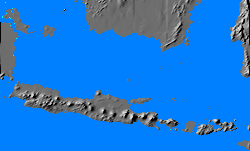![]() The Pacific War Online Encyclopedia
The Pacific War Online Encyclopedia
|
| Previous: Java | Table of Contents | Next: Jehol |

The Java Sea is a small, shallow sea
located between Java
to the south and Borneo
to
the north.
The Battle of the Java Sea was fought here on 27 February - 1 March 1942 between Japanese and Allied cruiser forces. The Japanese force was escorting an invasion convoy to Java which the Allied force tried unsuccessfully to break up. Though the two forces were roughly equal in numbers, the Japanese had the advantage of aerial reconnaissance and their superior training in night tactics, while the Allied ships had not trained together and did not even share the same communications protocols.
The Allied force had swept unsuccessfully for the Japanese earlier in the day and were entering Surabaya harbor when word came that a Japanese convoy had been spotted north of Java. Doorman immediately turned about and headed back west. He had no air reconnaissance because all his seaplanes had been left ashore in anticipation of a night engagement. The Dutch air commander chose to send his remaining fighters to escort a dive bomber strike against the convoy, rather than provide cover for the surface force.
The Japanese suffered from no such disadvantages, and at 1610 their float planes spotted the Allied force. Two minutes later the surface fleets spotted each other, and the Japanese attempted to cross Doorman's T. Doorman responded by ordering his cruisers to maximum speed, which the Dutch destroyers could not match. The Japanese heavy cruisers opened fire at 1616, at extreme range, while Tanaka in Jintsu opened fire on the British destroyers from outside their gun range. Doorman maneuvered so that the two opposing columns were sailing on nearly parallel courses and returned fire.
Since the Japanese had spotting aircraft and the Allies did not, the Japanese fire was more accurate. At 1631 De Ruyter was hit in an engine room by a dud shell. Doorman continued to close, and Takagi responded with a long-range torpedo attack. None of the 43 torpedoes hit. However, the Japanese destroyers simultaneously layed smoke screens, which further increased the Allies' disadvantage in gunnery accuracy.
By 1700 the Allies were closing on the Japanese transports, and at 1707 Tanaka ordered another torpedo attack to drive them back. A minute later Exeter was hit by a shell that exploded in an antiaircraft magazine, inflicting severe damage. Exeter immediately lost speed, throwing the Allied column into confusion just as the Japanese launched torpedoes. Kortenaer was hit by a torpedo and sank almost at once.
Takagi ordered another torpedo attack to take advantage of the Allied confusion. Electra inflicted light damage on Jintsu before being damaged herself. Meanwhile the Dutch destroyers drove back an attempt by Japanese destroyers to finish off Exeter. The Japanese turned on Electra and she sank at 1800.
At 1809 Destroyer Division 58 attempted to counterattack. The torpedoes were launched at long range at the Japanese easily maneuvered to avoid them.
Doorman continued to press towards the Japanese transports. At 1927 the Allied and Japanese cruiser forces once again sighted each other. At 1936 the captain of Perth sighted flashes that he interpreted as torpedo launchings. He maneuvered to evade and the other ships followed suit.
At 2100 the American destroyers, their torpedoes expended and low on fuel, departed for Surabaya. At 2125 the remaining Allied force stumbled into a fresh Dutch minefield and Jupiter was sunk with heavy loss of life.
At 2217 Doorman turned north again, passing through the flotsam from the sunken destroyers. The remaining destroyers in the Allied force dropped out to rescue survivors and were unable to rejoin the Allied force. This left the four remaining cruisers without destroyer support.
At 2300 the two cruiser forces sighted each other
again. The Japanese launched torpedoes at 2320, at a range of 8000
yards, and both De Ruyter and
Java were hit and sank shortly
thereafter. Doorman's last signal ordered the two remaining cruisers to
head at once to Batavia without
stopping to rescue survivors.
The battle was a decisive Japanese victory, with the Allies losing two cruisers and three destroyers without inflicting serious damage on the Japanese. The Allied defeat left Java wide open to invasion, and the Dutch defenders were forced to surrender a week later.
| ABDA Combined Striking Force (Doorman)
|
|||
| |
CA Houston |
||
| CA Exeter |
Severely damaged |
||
| CL Java |
Sunk |
||
| CL De
Ruyter |
Sunk |
||
| CL Perth |
|||
| Destroyer
Division 58 |
|||
| |
DD John
D. Edwards |
||
| DD Paul
Jones |
|||
| Destroyer
Division 59 |
|||
| DD John
D. Ford |
|||
| DD Alden | |||
| DD Electra |
Sunk |
||
| DD Jupiter |
Sunk |
||
| DD Encounter | |||
| DD Kortenaer | Sunk |
||
| DD Witte
de With |
|||
| Attack
Forces (Takahashi) |
||||
| |
Eastern
Attack Group (Nishimura) |
|||
| |
Transport
Unit |
|||
| |
41 AP |
|||
| Destroyer
Squadron 4 (Nishimura)
|
Remained with the transports and
did not engage |
|||
| CL Naka |
||||
| DD Yudachi |
||||
| DD Samidare | ||||
| DD Murasame | ||||
| DD Harusame | ||||
| DD Minegumo |
||||
| DD Asagumo | ||||
| Eastern
Covering Group (Takagi) |
||||
| CA Nachi |
||||
| CA Haguro | ||||
| Destroyer
Squadron 2 (Tanaka) |
||||
| CL Jintsu |
Lightly damaged |
|||
| DD Kawakaze |
||||
| DD Hatsukaze |
||||
| DD Yukikaze | ||||
| DD Yamakaze | ||||
| DD Tokitsukaze | ||||
| DD Ushio |
||||
| DD Sazaname | ||||
References
The Pacific War Online Encyclopedia © 2007 by Kent G. Budge. Index